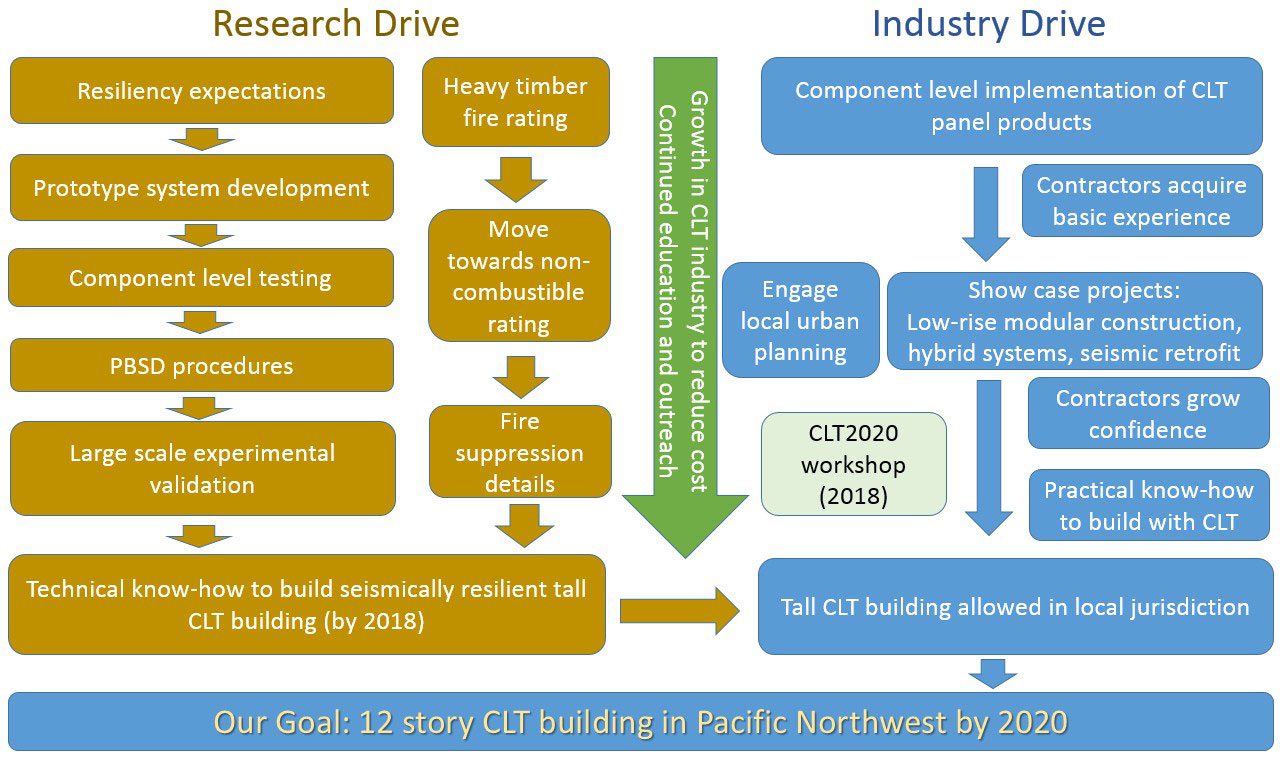This research project focuses on developing
seismically resilient tall Cross Laminated Timber (CLT) systems at 8~20 story height
range that can be cost competitive to be built in seismic regions of the U.S.
The researchers, collaborating with industry partners and stakeholders, propose
a vision to enable construction of the first CLT building in the U.S. over
10-story by the year 2020 (CLT2020).
In order to accomplish this vision, a roadmap for enabling building of tall CLT
structures in the U.S. was summarized based on Tall CLT Building Workshop held
in January 2014 in Seattle WA, as shown below.

The research team also proposed following tiered
performance expectations for tall CLT buildings under seismic loading (see
Table 1). The researchers are currently working on developing resilient
structural systems suitable for tall CLT construction. Please follow the
development of the project by visiting the website or contacting the project
PIs.
Seismic Hazard Levels (POE1)
|
System performance
|
Structural components
|
Non-structural components
|
Estimated Repair Time4
|
Tier 1: Code Minimum (Optimizing
current system and detailing, force-based design)
|
||||
Service
Level Earthquake
(50%
in 30 yrs.)
|
Immediate Occupancy:
Minor non-structural damage
|
Remain
Elastic
|
Minor
damage, repairable
|
1~7
days
|
Design
Basis Earthquake
(10%
in 50 yrs.)
|
Life
safety:
Extensive
structural damage allowed but not affecting stability
|
Lateral
system exhibit inelastic behavior, extensive repair can be done but costly
|
Moderate
damage, repairable
|
1-6
months
|
Maximum
Considered Earthquake
(2%
in 50 yrs.)
|
Collapse
prevention:
Severe
damage, Probability of Collapse <10%
|
Large
residual deformation, ductility fully developed, not repairable
|
Major
damage, not repairable
|
>
6 months
|
Near
Fault Ground Motions2
|
N/A
|
N/A
|
N/A
|
N/A
|
Tier 2: Code Plus (Innovative
detailing or advanced protection systems, PBSD)
|
||||
Service
Level Earthquake
(50%
in 30 yrs.)
|
Immediate
Occupancy
|
Elastic
|
Minor
damage, repairable
|
1~7
days
|
Design
Basis Earthquake
(10%
in 50 yrs.)
|
Limited/Planned
Damage
|
Lateral
system exhibit inelastic behavior, repair needed at planned locations
|
Moderate
damage, repairable
|
1~2
months
|
Maximum
Considered Earthquake
(2%
in 50 yrs.)
|
Life
safety:
Extensive
structural damage allowed but not affecting stability
|
Lateral
system exhibit inelastic behavior, repair may be costly
|
Moderate
damage, repairable
|
2~6
months
|
Near
Fault Ground Motions
|
Collapse
prevention:
Severe
damage, Probability of Collapse <10%
|
Large
residual deformation, ductility fully developed, not repairable
|
Major
damage, not repairable
|
>
6 months
|
Tier 3: Resilience (Resilient
structural systems implemented, PBSD)
|
||||
Service
Level Earthquake
(50%
in 30 yrs.)
|
Continuous
Operation
|
Elastic/Resilient
system operational
|
No
damage
|
0~30
min
|
Design
Basis Earthquake
(10%
in 50 yrs.)
|
Immediate
Occupancy
|
Resilient
system operational
|
Minor
contents damage
|
1~7
days
|
Maximum
Considered Earthquake
(2%
in 50 yrs.)
|
Planned
Damage3
|
Resilient
system repair needed at planned locations
|
Moderate
damage
|
1~2
months
|
Near
Fault Ground Motions
|
Limited
Damage
Probability
of Collapse negligible
|
Damage
extended to unplanned locations, repair may be costly
|
Moderate
damage
|
2~6
months
|
Project Description Link at NSF


